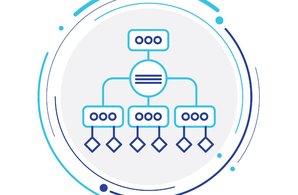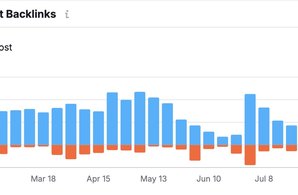Stop Losing Traffic: How to Detect and Fix Content Decay Before It's Too Late
- Home
- Knowledge Sharing
- Stop Losing Traffic: How to Detect and Fix Content Decay Before It's Too Late
Why Content Decay Can Wreck Your Traffic
Imagine publishing an article that once brought thousands of monthly visitors. Fast forward a year, and traffic has plummeted. What happened? You’re likely facing content decay – the gradual decline in organic traffic and engagement for once high-performing content. In today's competitive digital landscape, where 7.5 million blog posts are published daily, staying stagnant means falling behind. Regular content maintenance isn't optional; it's survival. Refreshed content can increase organic traffic by up to 106% , making routine audits and updates crucial for sustained success.
Content Decay refers to the gradual decline in a webpage's organic traffic and search engine rankings over time. From an SEO perspective, this happens when content becomes outdated, less relevant, or overshadows competitors' newer, more optimized content. Irina, SEO Strategist
What Is Content Decay and Why Should You Care?
Content decay occurs when your once top-ranking content slowly loses visibility and engagement. It doesn’t happen overnight but creeps in, costing you leads and conversions.
How to Spot It:
- Traffic drops: Pages losing significant monthly visits.
- Falling rankings: Keywords slipping from top SERP positions.
- Lower engagement: Increased bounce rates and decreased time on the page.
Why it matters: If your competitors update their content while yours stagnates, guess where users (and Google) will go?
If you've noticed issues with content decay on your website, start by checking the top Google results and analyzing your competitors. Your content may have become outdated, or Google might have changed its ranking algorithms. However, by conducting a detailed analysis of your competitors, you can always find ways to improve your page — whether updating information, adjusting the keyword density, or adding new sections and elements to your page. Alyona, Senior SEO Strategist
What Causes Content to Decay?
Knowing the "why" behind decay is crucial to fixing it.
Outdated Information
Old stats, expired promotions, or outdated laws make your content irrelevant.
Example : A DUI law article from 2018 still referencing old legal limits can misinform readers and hurt credibility.

Algorithm Updates
Google rolls out hundreds of updates yearly. Major changes like the Helpful Content Update target low-value pages, causing drops.
- Focus areas: Content quality, E-E-A-T (Experience, Expertise, Authoritativeness, Trustworthiness ).
Increased Competitor Activity
Competitors aren’t resting. They’re adding videos, infographics, and comprehensive guides .
Example : A plain text article on "home workouts" outperforms a competitor’s post featuring video demonstrations and downloadable plans.
Declining Relevance to Search Intent
User needs evolve. "Best phones 2022" doesn’t cut it in 2025.
Technical & Internal Linking Issues
- Broken links = poor user experience.
- Orphaned pages (no internal links) = ignored by search engines.
Example : An article without links to recent blog posts fails to leverage your site’s ecosystem.
How to Effectively Identify Content Decay
Content decay is an inevitable part of digital and real-world evolution. Even so-called 'evergreen content' isn’t immune to becoming outdated or losing relevance over time. Just because you've created outstanding content that initially ranks well and attracts the right audience doesn’t mean its success is guaranteed indefinitely. Without regular updates, it will stagnate, and fresher perspectives, deeper research, verified data, and more comprehensive case studies will inevitably push it down the rankings.
To stay ahead, always think two steps forward. Don't make the mistake of treating content as static—structure it in a way that allows for easy updates, repurposing, and expansion. A proactive approach to content strategy will not only extend its lifespan but also ensure it remains a valuable asset in an ever-evolving digital landscape. Mike Zhmudikov, SEO Director
Essential Tools for Monitoring Content Performance
-
Google Analytics:
Use to track fluctuations in traffic and user engagement. Key monitoring metrics include page views, average session duration, and user flow to identify declining pages.

- Google Search Console: Crucial for monitoring keyword rankings and identifying sudden drops in performance for high-traffic keywords . This tool also helps track issues like crawl errors or mobile usability problems.
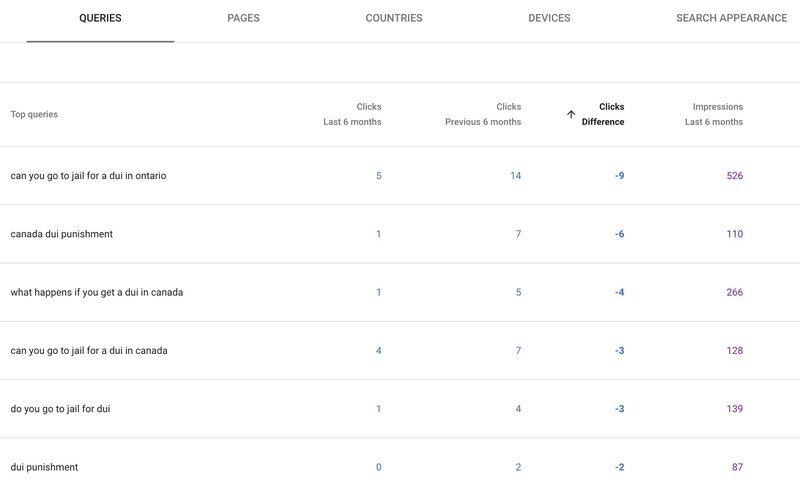
- Ahrefs / SEMrush: Leverage these SEO tools to track changes in backlink profiles, discover lost backlinks, and assess competitor performance. Monitoring your backlinks can reveal content decay if there’s a decline in referring domains or inbound links.

Key Metrics to Track
- Organic Traffic Trends: Analyze organic search traffic over the past 3-6 months to identify pages that have experienced significant drops or stagnation.
- Click-Through Rate (CTR): Low CTR can indicate that your content is no longer appealing or relevant to users, even if it ranks well.
- Bounce Rate & Session Duration: High bounce rates and short session durations are indicators that users aren't finding your content valuable or engaging, suggesting potential content decay.
- Keyword Rankings: Regularly monitor keyword positions. A steady decline in keyword rankings, especially for high-value terms, signals that content may no longer be relevant or optimized for search engines.
Consistently tracking key metrics like organic traffic, CTR, and keyword rankings is essential for maintaining content relevance. If you notice a steady decline, it's a clear sign that your content needs an update to meet user expectations and stay competitive in search results.
Mike Zhmudikov, SEO Director
Red Flags to Watch For
- Declining Traffic with Stable Site Performance: If specific pages lose traffic while the overall site’s performance remains stable, certain content may be outdated or no longer ranking well.
- Content Not Updated in 12+ Months: Content that hasn't been refreshed in over a year is more prone to becoming irrelevant or less authoritative, especially if newer information is now available.
-
Decrease in Backlinks or Referring Domains:
A drop in backlinks can signal that other websites no longer find your content valuable enough to link to, negatively impacting search engine rankings.
Analyzing Your Decaying Content: A Step-By-Step Guide
Audit Process
- Identify underperforming pages with the tools mentioned above.
- Compare with top competitors : Are they covering topics you missed?
-
Spot issues
: Outdated info? Broken links? Bland formatting?
What to Improve
Outdated Data? Update It.
- Why it matters: Information that is no longer accurate or relevant can quickly lead to a decline in search engine rankings and user trust. Updating outdated statistics, facts, or trends can help restore the page’s credibility and value.
- How to improve: Review your content regularly to ensure that all data points, such as statistics, dates, or references to current events, are up to date. If your content references outdated products, services, or technology, replace them with newer, more relevant examples.
-
Example:
We updated the information in this article to ensure it is accurate, current, and valuable for readers. We refreshed outdated data, clarified legal procedures, and included Canada's most recent DUI laws and penalties. Additionally, we enhanced the content with practical tips, updated resources, and clear steps to follow after a DUI arrest. These improvements make the article more comprehensive, informative, and user-friendly for individuals seeking guidance.
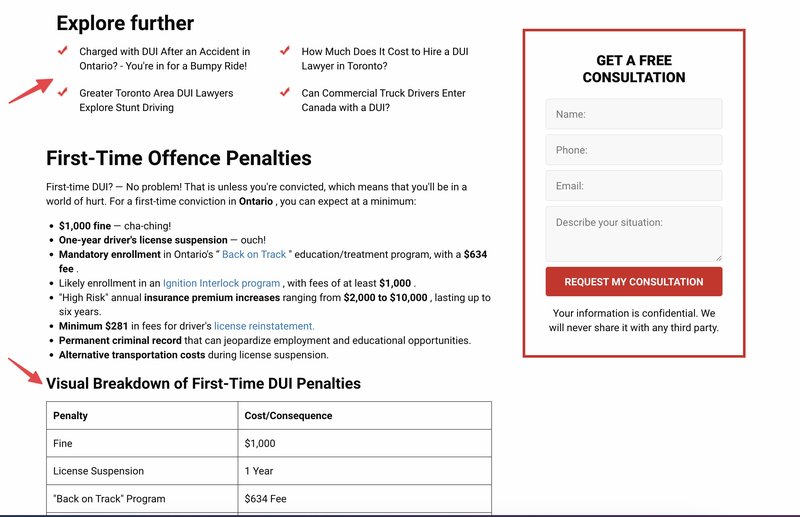
Are Keywords Irrelevant? Reoptimize.
- Why it matters: Search engine algorithms change over time, and keywords that once worked may no longer drive traffic. Regular keyword optimization helps your content align with current search trends and user intent.
- How to improve: Use tools like Google Search Console to identify keywords that are losing traction or are underperforming. Perform fresh keyword research to find new, relevant terms and incorporate them naturally into your content. Ensure your target keywords match user search intent and meet current demand.
- Example: We researched thoroughly and incorporated relevant keywords throughout the article. As a result, there has been a noticeable increase in keyword rankings, improving the article's visibility in search engines and making it easier for readers to find valuable information.
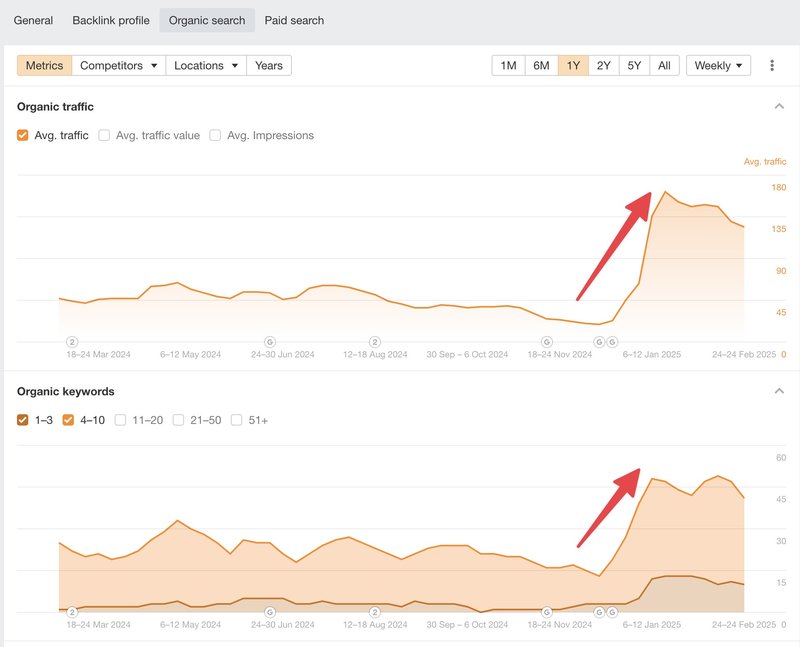
Thin Content? Expand It.
-
Why it matters:
Content that is too brief or lacks depth may not provide enough value to users or search engines, which could result in poor performance. Expanding your content can enhance its usefulness and improve its rankings.
How to improve: Add more details, examples, statistics, or expert insights to make the content more comprehensive. Aim to answer all potential questions users may have on the topic. Consider breaking down complex ideas into easy-to-understand sections with step-by-step guidance if the content is instructional or informative. -
Example:
To enhance the content's depth and value, we added detailed tables for each scenario, expert quotes to provide authoritative insights, and unique images to improve visual engagement. Additionally, we included a booking form within the article to make it easier for readers to take immediate action and connect with legal professionals. These improvements make the information more comprehensive, user-friendly, and engaging.
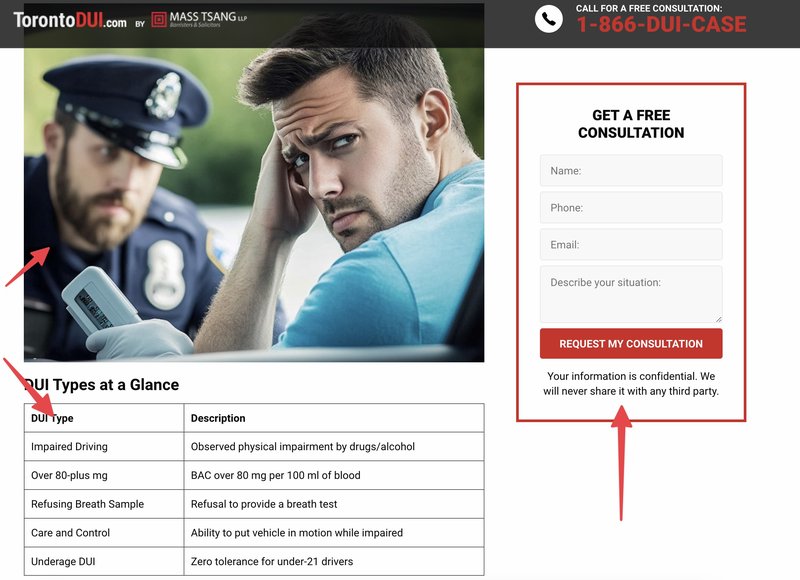
Lacking Internal Links? Add Them.
- Why it matters: Internal linking helps distribute page authority across your site, guiding users and search engines to valuable content. A lack of internal links can prevent users from discovering more of your content and may result in poor SEO performance.
- How to improve: Review your content to find opportunities to link to other relevant pages within your website. Add links to articles, product pages, or blog posts that are contextually related. Ensure the anchor text is natural and informative so it adds value to the user experience.
-
Example:
We improved the article’s structure by linking internally to relevant pages within the website, enhancing navigation and helping readers explore related topics. Additionally, we added links to credible external sources to provide trustworthy information and further support the content’s accuracy and authority.
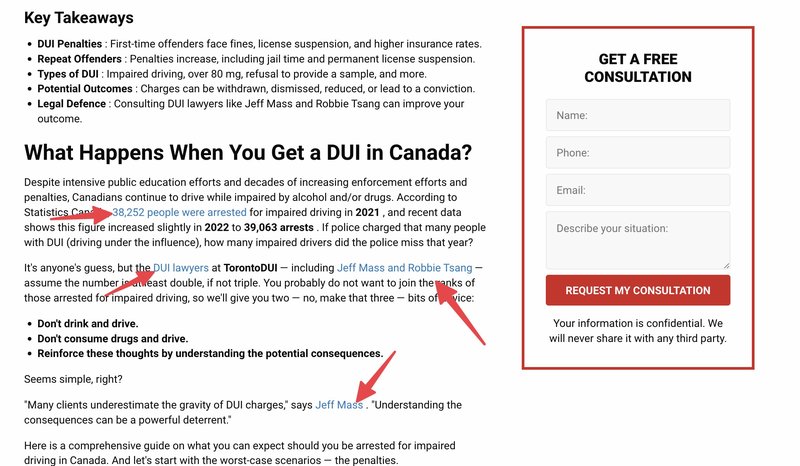
Engagement Low? Insert Multimedia.
- Why it matters: Content lacking engagement signals to users and search engines that the page may not be as valuable or appealing. Multimedia, like images, videos, infographics, and interactive elements, can significantly increase user interaction and time spent on the page.
- How to improve: Add relevant images, videos, infographics, or interactive elements like quizzes or calculators to make your content more engaging. Ensure all multimedia is high quality, optimized for loading speed, and relevant to the content.

We successfully increased the article’s traffic and improved its performance by implementing these steps. If you’ve noticed a website traffic decline, we encourage you to analyze your content and apply the recommendations we’ve demonstrated. For professional assistance in enhancing your website, reach out to us —
our team
is ready to help you achieve better results.
Battle-Tested Strategies to Reverse Content Decay
1. Regular Content Audits
Set quarterly or biannual reviews. Use templates to streamline.
2. Refresh Old Information
- Update stats, laws, and product details.
Example : Refreshing DUI penalties in a Toronto article boosted traffic by 151% in six months.
When you notice your content losing effectiveness, start by diagnosing the cause—outdated information, shifting user intent, or increased competition. Use analytics to identify traffic drops and engagement declines, then compare your page to the top-ranking results. Refresh outdated sections, improve readability, and enhance multimedia elements. Additionally, assess search intent changes—your audience's needs may have evolved, requiring a strategic content pivot. Consistently monitoring performance and iterating based on data will help keep your content relevant and competitive in search rankings. Alex, Junior SEO Strategist
3. Improve Keyword Targeting
Identify new opportunities. Rework headings and meta descriptions.
4. Enhance Internal Linking
- Connect to newer articles.
- Fix broken links.
5. Add photo and video.
Videos and infographics aren’t just lovely; they’re necessary.
6. Post-Update Monitoring
Track changes using the same tools that identified decay.
Can AI Help Prevent Content Decay?
AI tools can significantly identify and prevent content decay by streamlining the audit process and offering data-driven insights. Platforms like Clearscope and SurferSEO help analyze content for keyword relevance, gaps, and optimization opportunities faster than manual methods. They can quickly highlight areas where content is underperforming, suggest improvements, and benchmark your pages against top competitors.
However, while these tools are highly efficient, they aren’t flawless. Human oversight remains essential to ensure the content maintains nuance, context, and a natural tone that resonates with readers. AI might recommend adding keywords or adjusting content structure without understanding the article’s overall message or user intent, which can lead to robotic or awkward phrasing.
Don’t Let Your Hard Work Fade Away
Content decay is inevitable but preventable. Regular audits, timely updates, and innovative strategies can revive your pages and regain lost traffic.
Need expert help? Contact Seologist for professional content optimization services. Our team is ready to help you boost your website’s performance and drive sustainable traffic growth.

